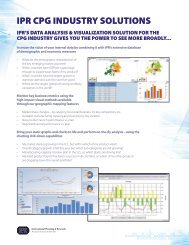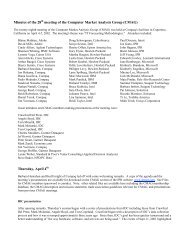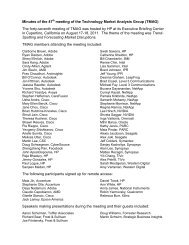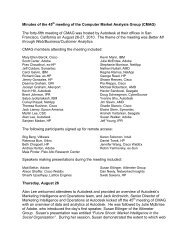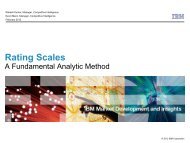The thirty-fourth meeting of CMAG was hosted by IBM at it - IPR ...
The thirty-fourth meeting of CMAG was hosted by IBM at it - IPR ...
The thirty-fourth meeting of CMAG was hosted by IBM at it - IPR ...
- No tags were found...
Create successful ePaper yourself
Turn your PDF publications into a flip-book with our unique Google optimized e-Paper software.
Minutes <strong>of</strong> the 34 th <strong>meeting</strong> <strong>of</strong> the Computer Market Analysis Group (<strong>CMAG</strong>)<br />
<strong>The</strong> <strong>thirty</strong>-<strong>fourth</strong> <strong>meeting</strong> <strong>of</strong> <strong>CMAG</strong> <strong>was</strong> <strong>hosted</strong> <strong>by</strong> <strong>IBM</strong> <strong>at</strong> <strong>it</strong>s Palisades facil<strong>it</strong>y in New<br />
Jersey on March 17-18, 2005. <strong>The</strong> theme <strong>of</strong> the <strong>meeting</strong> <strong>was</strong> Researching IT Services:<br />
How to Successfully Overcome Widespread Methodology Challenges.<br />
<strong>CMAG</strong> members <strong>at</strong>tending the <strong>meeting</strong> or particip<strong>at</strong>ing remotely included:<br />
Laurie Henneborn, Accenture<br />
Maia Jin, Accenture<br />
Arthur Rangel, Apple Computer<br />
Lidia Huk, AT&T<br />
Sherry Sum<strong>it</strong>s, Cisco Systems<br />
Atul Sahni, Computer Associ<strong>at</strong>es<br />
Ruxandra Golea, Dell<br />
Mary Jane Monsivais, Dell<br />
Jack Lamey, Epson America<br />
Marsha Haugen, Hewlett-Packard<br />
Mary Kulas, Hewlett-Packard<br />
Regina Ramos, Hewlett-Packard<br />
Liz Vugrinecz, Hewlett-Packard<br />
Cynthia Wolfe, Hewlett-Packard<br />
Cynthia Armstrong, <strong>IBM</strong><br />
Tim Bohling, <strong>IBM</strong><br />
Tim D'Souza, <strong>IBM</strong><br />
Laura Fonda, <strong>IBM</strong><br />
Thomas Galloway, <strong>IBM</strong><br />
Carol Galvin, <strong>IBM</strong><br />
Andrea Goldberg, <strong>IBM</strong><br />
Dan Greene, <strong>IBM</strong><br />
Kenneth Klee , <strong>IBM</strong><br />
Shari Morwood, <strong>IBM</strong><br />
Mark Pandick, <strong>IBM</strong><br />
Jos<strong>it</strong>a Tascione, <strong>IBM</strong><br />
Dan Whysong, <strong>IBM</strong><br />
Olga Hew<strong>it</strong>t, Intu<strong>it</strong><br />
Sue West, Intu<strong>it</strong><br />
Jeff Coldwell, <strong>IPR</strong><br />
Joe G<strong>at</strong>to, <strong>IPR</strong><br />
John Hagens, <strong>IPR</strong><br />
Edward Crowley, Lexmark<br />
Wendy Wh<strong>it</strong>e, Lexmark<br />
Daragh Gallagher-Carpenter, Lucent<br />
Barbara Ivey, Micros<strong>of</strong>t<br />
Inga Vailionis, NVIDIA<br />
Tricia Cummings, Sun Microsystems<br />
Robin Yarmovsky, Sun Microsystems<br />
Ralph Mahoney, Unisys<br />
Wes Osborn, Unisys<br />
Guests making present<strong>at</strong>ions <strong>at</strong> the <strong>meeting</strong> included:<br />
James Alexander, Alexander Consulting, LLP<br />
John Willmott, NelsonHall<br />
Liam Fahey, Leadership Forum, Inc.<br />
Lynne Weber, Standard & Poor’s Corpor<strong>at</strong>e Value Consulting<br />
John Gantz and Bob Welch, Intern<strong>at</strong>ional D<strong>at</strong>a Corpor<strong>at</strong>ion<br />
Thursday, March 17<br />
Winn Brown, Vice President, Corpor<strong>at</strong>e Market Intelligence, <strong>IBM</strong> welcomed the group and<br />
briefly described <strong>IBM</strong>’s experience w<strong>it</strong>h MI. In<strong>it</strong>ially the focus <strong>was</strong> on building skills and<br />
gaining trust. <strong>IBM</strong>’s focus next moved to building trust on MI’s insights and recommend<strong>at</strong>ions.<br />
<strong>The</strong> current focus for MI <strong>at</strong> <strong>IBM</strong> is on driving action and being accountable. Winn believes th<strong>at</strong><br />
IT services are ripe for strong market intelligence work, but pointed out the difficulties as a result<br />
<strong>of</strong> the large number <strong>of</strong> compet<strong>it</strong>ors and the fact th<strong>at</strong> services are hard to count and measure.<br />
Wes Osborn <strong>of</strong> Unisys introduced the day’s first inv<strong>it</strong>ed speaker, James Alexander <strong>of</strong> Alexander<br />
Consulting. <strong>The</strong> theme <strong>of</strong> Jim’s present<strong>at</strong>ion <strong>was</strong> “Marketing IT Services and Solutions.” After
introducing the group to his recent book, S-Business: Reinventing the Services Organiz<strong>at</strong>ion, w<strong>it</strong>h<br />
copies provided to all <strong>meeting</strong> <strong>at</strong>tendees, Jim began his talk <strong>by</strong> tackling some defin<strong>it</strong>ions.<br />
Products are tangible <strong>of</strong>ferings, while services are intangible <strong>of</strong>ferings, w<strong>it</strong>h the l<strong>at</strong>ter usefully<br />
spl<strong>it</strong> between break/fix services and pr<strong>of</strong>essional services. Jim defines a solution as a bundle <strong>of</strong><br />
products and services in which the combin<strong>at</strong>ion is gre<strong>at</strong>er than the sum <strong>of</strong> <strong>it</strong>s parts (1+1=3) and a<br />
total solution covers the entire need w<strong>it</strong>h respect to an important business issue. Finally, Jim has<br />
developed the concept <strong>of</strong> an S-Business as an organiz<strong>at</strong>ion th<strong>at</strong> “pushes” services th<strong>at</strong> “pulls” in<br />
products. Jim is very bullish on IT services since the technology assimil<strong>at</strong>ion gap, a measure <strong>of</strong><br />
the demand for services, continues to grow rapidly. Services companies fall w<strong>it</strong>hin one <strong>of</strong> four<br />
quadrants: vendors selling commod<strong>it</strong>y services who need to be lean and mean to be compet<strong>it</strong>ive,<br />
specialists who provide world class capabil<strong>it</strong>ies in niche areas, total solution providers who <strong>of</strong>fer<br />
one-stop shopping, and game changers who are the thought leaders and who can earn the gre<strong>at</strong>est<br />
returns. Each service str<strong>at</strong>egy can be successful. Jim next summarized his recent study <strong>of</strong> 157<br />
service organiz<strong>at</strong>ions. He found th<strong>at</strong> pr<strong>of</strong>essional services are gaining share from products and<br />
break/fix services. In contrast to the past, Jim found th<strong>at</strong> pr<strong>of</strong>essional services now gener<strong>at</strong>e<br />
gross margins in line w<strong>it</strong>h those earned <strong>by</strong> products and break/fix services and th<strong>at</strong> their growth<br />
r<strong>at</strong>e is 2-3 times gre<strong>at</strong>er. He next turned to the challenges <strong>of</strong> marketing pr<strong>of</strong>essional services,<br />
st<strong>at</strong>ing th<strong>at</strong> the marketing and selling skills needed are different from wh<strong>at</strong> is needed in selling<br />
products. He observed th<strong>at</strong> firms <strong>at</strong>tempting to grow their service businesses in response to the<br />
gre<strong>at</strong> opportun<strong>it</strong>y <strong>of</strong>ten do not put in place effective marketing and sales plans. He identified key<br />
elements <strong>of</strong> such plans <strong>by</strong> summarizing the practices <strong>of</strong> the top performers. In depth research<br />
w<strong>it</strong>h the key accounts <strong>by</strong> senior management (and an experienced MI staff person) is a key<br />
recommend<strong>at</strong>ion.<br />
<strong>The</strong> morning’s second speaker <strong>was</strong> John Willmott <strong>of</strong> NelsonHall. John <strong>was</strong> introduced <strong>by</strong> Shari<br />
Morwood <strong>of</strong> <strong>IBM</strong> and spoke on the topic <strong>of</strong> “Meeting the Challenges <strong>of</strong> BPO Market Research.”<br />
John covered four areas: defining BPO, segmenting and sizing the BPO market, researching<br />
customer requirements from BPO, and the future <strong>of</strong> BPO. After providing a straightforward<br />
defin<strong>it</strong>ion <strong>of</strong> BPO (the outsourcing <strong>of</strong> business functions or processes to a third party), John<br />
reviewed several <strong>it</strong>ems th<strong>at</strong> make the applic<strong>at</strong>ion <strong>of</strong> this defin<strong>it</strong>ion challenging, to say the least.<br />
Taken to <strong>it</strong>s logical extreme, almost all intermedi<strong>at</strong>e transactions can be viewed as BPO.<br />
Defin<strong>it</strong>ional conventions have been used to reign in the boundaries <strong>of</strong> BPO. For example,<br />
NelsonHall excludes stand-alone consultancies, IT services and IT outsourcing, helpdesk<br />
services provided for the client’s internal personnel, captive centers, and business services. John<br />
next discussed NelsonHall’s BPO segment<strong>at</strong>ion structure. NH groups these into blue and wh<strong>it</strong>e<br />
collar services, w<strong>it</strong>h wh<strong>it</strong>e collar services spl<strong>it</strong> into front-<strong>of</strong>fice, middle-<strong>of</strong>fice, and back-<strong>of</strong>fice<br />
c<strong>at</strong>egories. Each <strong>of</strong> these c<strong>at</strong>egories is further divided and sub-divided. To size the BPO market<br />
John strongly recommends th<strong>at</strong> a supply-side approach be used desp<strong>it</strong>e the fact th<strong>at</strong> the leading<br />
vendor in a typical BPO market has only 5-20% share. NelsonHall also g<strong>at</strong>hers contract<br />
inform<strong>at</strong>ion to gain more insight on the BPO market. As an example, John reviewed<br />
NelsonHall’s estim<strong>at</strong>es <strong>of</strong> the HR outsourcing market. He summarized his views on BPO market<br />
sizing w<strong>it</strong>h the following principles: define the market tightly, identify the leading vendors, don’t<br />
believe the size unless the identified vendors make up 50%+ <strong>of</strong> the market and the leading vendor<br />
has more than 5% share, and user-based market sizing doesn’t work. John next turned to<br />
researching customer requirements and suggested several principles including understanding the<br />
customer’s business issues, process strengths/weaknesses, investment prior<strong>it</strong>ies, management<br />
capabil<strong>it</strong>y, and views on outsourcing. NelsonHall’s research identifies several benef<strong>it</strong>s sought<br />
from BPO, w<strong>it</strong>h lower cost for transactional services being the more frequently mentioned. John<br />
concluded his present<strong>at</strong>ion <strong>by</strong> summarizing his views on the future <strong>of</strong> BPO.
Following lunch, John Hagens <strong>of</strong> <strong>IPR</strong> introduced the afternoon’s first speaker, Liam Fahey <strong>of</strong><br />
Leadership Forum, Inc. who spoke on “Getting Inside the Customer’s Mind: Capturing,<br />
Aggreg<strong>at</strong>ing and Leveraging Customer Emotions.” Liam motiv<strong>at</strong>ed the need to capture and<br />
analyze emotions <strong>by</strong> illustr<strong>at</strong>ing their role in customer behavior. Given the apparent importance<br />
<strong>of</strong> emotions, he next listed several questions th<strong>at</strong> need to be addressed to make the understanding<br />
<strong>of</strong> customer emotions oper<strong>at</strong>ional: defining wh<strong>at</strong> we mean <strong>by</strong> emotion, how do they connect to<br />
business issues, how can they be captured and analyzed, wh<strong>at</strong> outputs are possible and how can<br />
they be used in decision-making, and how can the results be tracked. After reviewing several<br />
methodological challenges surrounding these questions, Liam presented his emotion-mining<br />
pyramid <strong>of</strong> four layers. At the top <strong>of</strong> the pyramid are simple top-<strong>of</strong>-mind emotions th<strong>at</strong> Liam<br />
believes do not drive behavior. Moving down through the emotion layers (from “top-<strong>of</strong>-mind”, to<br />
“I think <strong>it</strong>, but I don’t say <strong>it</strong>”, to “I sense <strong>it</strong>, but I can’t express <strong>it</strong>”, and finally to “I am not aware<br />
<strong>of</strong> <strong>it</strong>, but I can recognize <strong>it</strong>”) one obtains a clearer understanding <strong>of</strong> behavior drivers. This is the<br />
essence <strong>of</strong> emotion mining – an understanding <strong>of</strong> wh<strong>at</strong> the customer feels. Liam next explained<br />
his “emotion bridge” between a customer’s needs and the experience provided <strong>by</strong> the company.<br />
Several examples <strong>of</strong> the applic<strong>at</strong>ions <strong>of</strong> emotion mining were provided covering pos<strong>it</strong>ioning, ad<br />
testing, and compet<strong>it</strong>or analysis. Liam next used an online video to present his method <strong>of</strong><br />
capturing customer emotions in a web-enabled applic<strong>at</strong>ion. After illustr<strong>at</strong>ing the range <strong>of</strong> uses <strong>of</strong><br />
emotion mining, Liam presented a detailed example <strong>of</strong> a recent IT services project th<strong>at</strong> employed<br />
his technique.<br />
Ed Crowley <strong>of</strong> Lexmark delivered the <strong>meeting</strong>’s first “War Story”, which <strong>was</strong> ent<strong>it</strong>led “Building<br />
a New Organiz<strong>at</strong>ion w<strong>it</strong>h Caffeine and Sleep Depriv<strong>at</strong>ion.” Ed described his role in building<br />
Lexmark’s market intelligence capabil<strong>it</strong>y, which is now a key part <strong>of</strong> executive decision making.<br />
He decided to start a new venture, Photizo Group, on his own after-hours time to share his<br />
learning and passion for enhancing the IT market intelligence vision. Started in early 2004,<br />
Photizo has released five issues <strong>of</strong> <strong>it</strong>s magazine and has built a webs<strong>it</strong>e which has grown<br />
continuously in vis<strong>it</strong>s. Ed believes th<strong>at</strong> he has identified a need and a vision, pulled together the<br />
right team, and is constantly striving to improve Photizo’s <strong>of</strong>ferings. He’s learned some good<br />
lessons as well: <strong>it</strong>’s easier for a company to “like the product” than to actually buy <strong>it</strong>, you should<br />
estim<strong>at</strong>e the amount <strong>of</strong> time for a project and double <strong>it</strong>, you need to identify which <strong>of</strong> several<br />
opportun<strong>it</strong>ies to pursue, and you can’t give up since success takes time. Photizo’s biggest<br />
challenges are building credibil<strong>it</strong>y, cre<strong>at</strong>ing awareness, selling the bigger MI concept instead <strong>of</strong><br />
MR, and, in his case, managing two jobs (w<strong>it</strong>h the benef<strong>it</strong>s <strong>of</strong> caffeine and l<strong>at</strong>e nights). In<br />
add<strong>it</strong>ion to providing copies <strong>of</strong> the February/March issue <strong>of</strong> the Photizo Intelligence Briefing to<br />
<strong>meeting</strong> <strong>at</strong>tendees, Ed is <strong>of</strong>fering <strong>CMAG</strong> members a special price ($99 instead <strong>of</strong> the regular<br />
$199) for a one-year subscription <strong>of</strong> six issues. Please contact Ed for details:<br />
eacrowley@photizogroup.com.<br />
Tommy Galloway <strong>of</strong> <strong>IBM</strong> followed w<strong>it</strong>h the second <strong>CMAG</strong> “War Story”, ent<strong>it</strong>led “Is Your<br />
Market Intelligence Ready to Support and Industry Focus?” W<strong>it</strong>h overall IT growth in the midsingle<br />
dig<strong>it</strong>s, Tommy believes th<strong>at</strong> an industry focus for MI is necessary to identify the pockets <strong>of</strong><br />
stronger growth companies are expecting. Market intelligence <strong>at</strong> <strong>IBM</strong> mostly supports industries<br />
in an ad hoc fashion, w<strong>it</strong>h full coverage for market opportun<strong>it</strong>y analysis, partial coverage for<br />
other areas, and l<strong>it</strong>tle to no coverage for compet<strong>it</strong>ive intelligence. Tommy reviewed a number <strong>of</strong><br />
examples for select industries (government, pharmaceuticals, educ<strong>at</strong>ion, and healthcare) to show<br />
how specific needs differ significantly across industries. He then discussed how <strong>IBM</strong> is “building<br />
a bridge” to get to a higher level <strong>of</strong> industry market intelligence.<br />
Andrea Goldberg and Tim Bohling <strong>of</strong> <strong>IBM</strong> presented the third war story which focused on<br />
“Measuring Market Share.” As a result <strong>of</strong> the Sarbanes-Oxley legisl<strong>at</strong>ion, <strong>IBM</strong> implemented
Project Magellan to develop specific guidelines for the reporting and measuring <strong>of</strong> market share.<br />
Several issues were addressed including tre<strong>at</strong>ment <strong>of</strong> internal vs. external sales (green vs. blue<br />
dollars), the identific<strong>at</strong>ion <strong>of</strong> reporting confidence tiers, and share variabil<strong>it</strong>y analysis. Cisco<br />
commented th<strong>at</strong> <strong>it</strong> uses secondary vendors and <strong>it</strong> doesn’t report market share. Hewlett-Packard<br />
st<strong>at</strong>ed th<strong>at</strong> <strong>it</strong> uses common defin<strong>it</strong>ions, external sources, and consistent methodologies in<br />
reporting market share in a well-documented process. Andrea agreed to look into whether she<br />
could share the <strong>IBM</strong> market share guidelines w<strong>it</strong>h the other <strong>CMAG</strong> companies.<br />
To complete the first day, John Hagens <strong>of</strong> <strong>IPR</strong> led a discussion <strong>of</strong> <strong>CMAG</strong> business. It <strong>was</strong><br />
announced th<strong>at</strong> Hewlett-Packard had <strong>of</strong>fered to host the next <strong>CMAG</strong> <strong>meeting</strong> <strong>at</strong> one <strong>of</strong> <strong>it</strong>s<br />
facil<strong>it</strong>ies in Silicon Valley. It <strong>was</strong> agreed th<strong>at</strong> the <strong>meeting</strong> would be scheduled for September 15-<br />
16, 2005. <strong>The</strong> group brainstormed on several subjects for the next <strong>meeting</strong> (summarized below).<br />
After the <strong>meeting</strong> adjourned for the day, the group enjoyed a relaxing and convivial reception and<br />
dinner <strong>at</strong> the Palisades.<br />
Friday, March 18<br />
Shari Morwood <strong>of</strong> <strong>IBM</strong> introduced Friday’s first speaker, Lynne Weber <strong>of</strong> Standard & Poor’s<br />
Corpor<strong>at</strong>e Value Consulting (CVC) who spoke on “Optimizing the Design <strong>of</strong> Services<br />
Businesses.” After briefly discussing where her group f<strong>it</strong>s w<strong>it</strong>hin S&P, Lynne discussed how<br />
market intelligence, primary research, and modeling can be used to improve the pr<strong>of</strong><strong>it</strong>abil<strong>it</strong>y <strong>of</strong> a<br />
service business. She first focused on projecting the demand for a service to support investments,<br />
transactions, design, and planning. <strong>The</strong> standard demand questions need to be addressed: wh<strong>at</strong> is<br />
the size <strong>of</strong> the opportun<strong>it</strong>y, wh<strong>at</strong> share can be achieved, how do we price to balance share and<br />
pr<strong>of</strong><strong>it</strong>, how quickly will customers adopt, and wh<strong>at</strong> are our most pr<strong>of</strong><strong>it</strong>able market segments for<br />
targeting. Different s<strong>it</strong>u<strong>at</strong>ions require different demand projection techniques. Lynne focused on<br />
one case study covering hardware maintenance/service contracts. In this case a model <strong>of</strong><br />
individual customer preferences <strong>was</strong> the best approach to projecting demand. <strong>The</strong> model<br />
included a number <strong>of</strong> service “levers” such as contract length, response time, and customer<br />
training. Based on the study, the client introduced an after-hours service and the model predicted<br />
the results w<strong>it</strong>h high accuracy. Next Lynne turned to a service design example in which the client<br />
wanted to rework <strong>it</strong>s existing tiers <strong>of</strong> service. In this case an OpenFraming approach <strong>was</strong> used to<br />
identify a broad set <strong>of</strong> altern<strong>at</strong>ive str<strong>at</strong>egies, which were then integr<strong>at</strong>ed into a market model<br />
using a value-based segment<strong>at</strong>ion scheme. <strong>The</strong> result <strong>was</strong> a major redesign <strong>of</strong> the company’s<br />
service portfolio and a very successful introduction <strong>of</strong> a new <strong>of</strong>fering which has <strong>at</strong>tracted the<br />
most desirable sub-popul<strong>at</strong>ion, per the prediction <strong>of</strong> the model. Finally, Lynne described how<br />
CVC’s approaches have been used to address key service staffing issues. A set <strong>of</strong> models were<br />
developed to project service contract demand, service incidents, and staffing requirements.<br />
Several oper<strong>at</strong>ional questions were answered <strong>by</strong> this modeling system.<br />
Robin Yarmovsky <strong>of</strong> Sun introduced the <strong>meeting</strong>’s final speakers, John Gantz and Bob Welch <strong>of</strong><br />
IDC. John and Bob focused on “IT Services Faces the New Age.” John spoke first on several<br />
technology transform<strong>at</strong>ions ahead th<strong>at</strong> would present new opportun<strong>it</strong>ies for IT services. <strong>The</strong>se<br />
included diversifying <strong>of</strong>fshoring, voice over IP, mobil<strong>it</strong>y, invisible computing, and interactiv<strong>it</strong>y.<br />
John identified specific impacts on services from each <strong>of</strong> these transform<strong>at</strong>ions. Next Bob<br />
summarized several other observed trends in IT services. Winning in services requires choosing<br />
the pr<strong>of</strong><strong>it</strong>able sectors and deals; enabling real business performance <strong>at</strong> the lowest possible cost;<br />
using outsourcing as a channel for delivery <strong>of</strong> consult<strong>at</strong>ive or transform<strong>at</strong>ional services; having<br />
“verticalized” solutions encompassing business process, applic<strong>at</strong>ions, IT and BP infrastructure;<br />
commod<strong>it</strong>izing special capabil<strong>it</strong>ies to lower cost; and partnering as a core competence. Finally,
John reviewed IDC’s approach to market description and sizing for services. He emphasized the<br />
need for a well founded market taxonomy which is mutually exclusive, collectively exhaustive<br />
(MECE). Based on this approach, IDC has a number <strong>of</strong> views <strong>of</strong> services (activ<strong>it</strong>y based,<br />
found<strong>at</strong>ion markets, extraction markets, and business functions). IDC’s primary method <strong>of</strong> sizing<br />
services is to utilize end-user surveys on spending <strong>by</strong> vertical and size class <strong>by</strong> country/region.<br />
This approach captures both internal and external services spending and is valid<strong>at</strong>ed/reconciled<br />
w<strong>it</strong>h supply-side d<strong>at</strong>a. John walked through IDC’s method <strong>of</strong> collecting and analyzing both<br />
demand size and supply size d<strong>at</strong>a th<strong>at</strong> is reconciled to produce <strong>it</strong>s services estim<strong>at</strong>es. He also<br />
identified a number <strong>of</strong> issues to worry about: vertical/size class spl<strong>it</strong>s, revenue classific<strong>at</strong>ion,<br />
revenue <strong>by</strong> geography, captive revenue, pass-through revenue, exchange r<strong>at</strong>es, and size <strong>of</strong> the<br />
“other” vendors.<br />
John Hagens wrapped up the <strong>thirty</strong>-<strong>fourth</strong> <strong>meeting</strong> <strong>of</strong> <strong>CMAG</strong> <strong>by</strong> resuming the discussion <strong>of</strong><br />
<strong>CMAG</strong> business. <strong>The</strong> group reviewed, extended, and consolid<strong>at</strong>ed the topics for the next <strong>meeting</strong><br />
th<strong>at</strong> were brainstormed the previous day. Seven potential topics were identified: customer<br />
research, intern<strong>at</strong>ional research, segment<strong>at</strong>ion research, channel/partner/SMB research,<br />
forecasting, market intelligence efficiency/innov<strong>at</strong>ion, and market intelligence customers. After<br />
further discussion and two rounds <strong>of</strong> voting, the group settled on market intelligence<br />
efficiency/innov<strong>at</strong>ion as the theme for the <strong>thirty</strong>-fifth <strong>CMAG</strong> <strong>meeting</strong>. Individuals who<br />
volunteered for the agenda comm<strong>it</strong>tee are: Marsha Haugen/HP, Shari Morwood/<strong>IBM</strong>, Ed<br />
Crowley/Lexmark, Inga Vailionis/NVIDIA, Robin Yarmovsky/Sun, and John Hagens/<strong>IPR</strong>.<br />
Inform<strong>at</strong>ion for this upcoming <strong>CMAG</strong> <strong>meeting</strong> on September 15-16 <strong>at</strong> HP will be out <strong>by</strong> early<br />
summer.<br />
Many thanks to Shari Morwood and Kerry Ponce for making the <strong>thirty</strong>-<strong>fourth</strong> <strong>meeting</strong> <strong>of</strong> <strong>CMAG</strong><br />
such an enjoyable experience!



